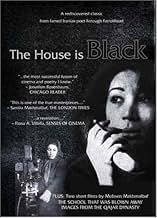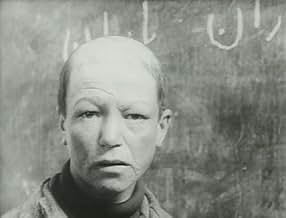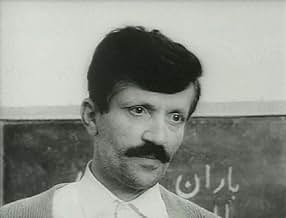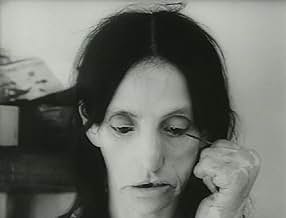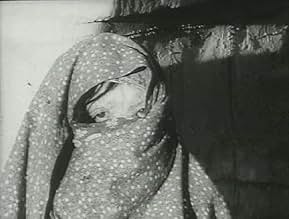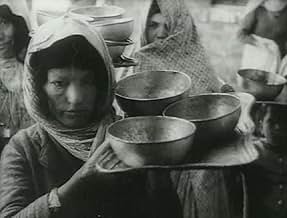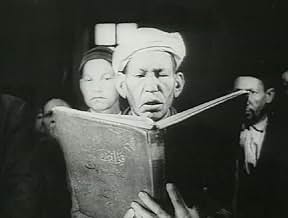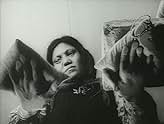Khaneh siah ast
- 1963
- 20 मि
IMDb रेटिंग
7.8/10
6 हज़ार
आपकी रेटिंग
अपनी भाषा में प्लॉट जोड़ेंSet in a leper colony in the north of Iran, The House is Black juxtaposes "ugliness", of which there is much in the world as stated in the opening scenes, with religion and gratitude.Set in a leper colony in the north of Iran, The House is Black juxtaposes "ugliness", of which there is much in the world as stated in the opening scenes, with religion and gratitude.Set in a leper colony in the north of Iran, The House is Black juxtaposes "ugliness", of which there is much in the world as stated in the opening scenes, with religion and gratitude.
- निर्देशक
- लेखक
- स्टार
Forugh Farrokhzad
- Narrator
- (बिना क्रेडिट के)
Ebrahim Golestan
- Narrator
- (बिना क्रेडिट के)
Hossein Mansouri
- Self
- (बिना क्रेडिट के)
फ़ीचर्ड समीक्षाएं
Masterpiece is the basis of a documentary of its time to this day.
Therefore, Iran's documentary career honor the backing of this work.
Although successful movies have been seen in the Iranian documentary cinema from the first to present day, the collaboration of Ebrahim Golestan and Dear Forough Farrokhzad with documentary subjects has largely distinguished this film.
The documentary refers to a place where lepers people are taken from quarantined villagers.
The colony of lepers living together in an enclosed environment.
The most important thing in the audience's beliefs, as the name suggests, is the mere darkness of the world of leprosy, but with a particular look it can be concluded that the general documented theme is life expectancy.
This look can be viewed from a more in-depth angle at the wedding, kids' play and classroom. Because they laugh, despite physical problems, they play and even get married.
In any case, we can not rule out that the glass of water, in addition to half empty, has full half.
Forough Farrokhzad have lived for about ten days in order to accompany and coordinate of filming, and this represents a great spirit and professional approach.
Signs indicate that the documentary has the 19th place among the fifty documentary titles in the world, in the site and sond, which is typically a special art work for Iran.
Every man is as ugly as the latter in the eyes of a beast. On the outside we are all humans. Inwardly we are all humans. Human suffering is inevitable, thus universal. As well as happiness.
`There is no shortage of ugliness in the world.' the opening voice-over states as we see a horribly disfigured woman staring into a mirror. And by the film's end, we truly get an understanding of what she means.
`Khaneh siah ast' (The House is Black), written, directed and edited in 1963 by Forugh Farrokhzad is a brilliant piece of work done on an issue that has hardly been portrayed in any kind of film, fiction or non. Filmed in B&W on location somewhere on a Middle Eastern island, the film portrays a rapid series of events during the everyday lives of all of its inhabitants that are suffering from various stages of leprosy.
Cinematographer Soleiman Minasian uses mainly natural light and captures the pure essence of what living with leprosy is actually like. It is very startling. All the more startling due to Farrokhzad's rapid editing and cutting and disorienting flash-pans. And although the film is a documentary, there are certain scenes, which are entirely fabricated and contrived. One scene in particular is an actual tracking shot through a classroom where there is a coherent edited sequence of dialogue spoken between a teacher and his student. And although no one in the film is an actor, the scene was indeed scripted.
The reason the film is so brilliant is because Farrokhzad juxtaposes the images with extremely religious voice-over narration. Each individual that has leprosy prays to God and gives thanks for being alive in this world. It is harshly ironic that all living lepers are giving thanks and praise to a God that forces them to live through painful physical suffering everyday of their life.
They say leprosy is a curable disease, however, the impact and feeling you get from experiencing this film, is not.
`Khaneh siah ast' (The House is Black), written, directed and edited in 1963 by Forugh Farrokhzad is a brilliant piece of work done on an issue that has hardly been portrayed in any kind of film, fiction or non. Filmed in B&W on location somewhere on a Middle Eastern island, the film portrays a rapid series of events during the everyday lives of all of its inhabitants that are suffering from various stages of leprosy.
Cinematographer Soleiman Minasian uses mainly natural light and captures the pure essence of what living with leprosy is actually like. It is very startling. All the more startling due to Farrokhzad's rapid editing and cutting and disorienting flash-pans. And although the film is a documentary, there are certain scenes, which are entirely fabricated and contrived. One scene in particular is an actual tracking shot through a classroom where there is a coherent edited sequence of dialogue spoken between a teacher and his student. And although no one in the film is an actor, the scene was indeed scripted.
The reason the film is so brilliant is because Farrokhzad juxtaposes the images with extremely religious voice-over narration. Each individual that has leprosy prays to God and gives thanks for being alive in this world. It is harshly ironic that all living lepers are giving thanks and praise to a God that forces them to live through painful physical suffering everyday of their life.
They say leprosy is a curable disease, however, the impact and feeling you get from experiencing this film, is not.
I hope my son's upcoming college class on Iranian film will be enlightening and enjoyable. In preparation for that, his instructor asked him to watch this short from Forugh Farrokhzad.
I had heard her name before but thought she was exclusively a writer (and one I have not yet read, alas).
Seeing this film....and reading a little more about her, was illuminating. And added to the spell that Iranian art has cast upon me.
It starts with an image, a reflection in a mirror. A scarred face, covered both by hijab and leprosy - with one eye searching. Who is watching who?
Actually, that is a lie. It starts with words. As befits a poet.
The film is available online, and I would almost recommend just reading the subtitles once through (or if they are excerpted somewhere, read them there before watching). Granted, I can only take in English, my tongue far from mastering Farsi. So hearing the words, Farrokhzad's long-gone but still-not-silent voice are part of the experience. Soft repetitions, almost mantras or prayers. Much questioning.
Is this the film that launched Kiarostami, Farhadi and others? There is an unflinching look at society. There is a tendency towards a more poetic than precise description. Thought above plot. Images too that may contrast the official story, of the film....or of the censors.
Images linger too - aspects of beauty, the combing of hair, and a camera pan to reveal. The applying of kohl with ravaged hands to a ravaged face. Still there is pride, there is beauty. The camera jumps into the middle of a volleyball game. We are there with them. We are them.
I do think that is the simple story here, Davids Bowie and Lynch gave us "Elephant Man." Farrokhzad moves through similar stark shadows. Honestly there is more light here. In a documentary. That dancing/singing/humming man. The laughter in the class room. Food, music, learning, work, love - these define us all as humans.
Anyways, I look forward to watching the movies in parallel with my son and his classmates. I've previously seen about half of them, which I will enjoy revisiting, like meeting up with a dear forgotten friend. But new introductions like these, I too will cherish.
Reading up on Farrokhzad, it is hard not to think of the film at least partially as a pariah dismissing those who dismiss her. There is a cure for leprosy, the film plainly repeats, though it is not a soft prayer, it is a hard fact. That said there is a biological cure, but perhaps not a societal one.
Like the great Iranian films that followed this one, there may be something that is not said and said at the same time.
There is so much beneath the surface. Of cinema, of society, of skin.
I had heard her name before but thought she was exclusively a writer (and one I have not yet read, alas).
Seeing this film....and reading a little more about her, was illuminating. And added to the spell that Iranian art has cast upon me.
It starts with an image, a reflection in a mirror. A scarred face, covered both by hijab and leprosy - with one eye searching. Who is watching who?
Actually, that is a lie. It starts with words. As befits a poet.
The film is available online, and I would almost recommend just reading the subtitles once through (or if they are excerpted somewhere, read them there before watching). Granted, I can only take in English, my tongue far from mastering Farsi. So hearing the words, Farrokhzad's long-gone but still-not-silent voice are part of the experience. Soft repetitions, almost mantras or prayers. Much questioning.
Is this the film that launched Kiarostami, Farhadi and others? There is an unflinching look at society. There is a tendency towards a more poetic than precise description. Thought above plot. Images too that may contrast the official story, of the film....or of the censors.
Images linger too - aspects of beauty, the combing of hair, and a camera pan to reveal. The applying of kohl with ravaged hands to a ravaged face. Still there is pride, there is beauty. The camera jumps into the middle of a volleyball game. We are there with them. We are them.
I do think that is the simple story here, Davids Bowie and Lynch gave us "Elephant Man." Farrokhzad moves through similar stark shadows. Honestly there is more light here. In a documentary. That dancing/singing/humming man. The laughter in the class room. Food, music, learning, work, love - these define us all as humans.
Anyways, I look forward to watching the movies in parallel with my son and his classmates. I've previously seen about half of them, which I will enjoy revisiting, like meeting up with a dear forgotten friend. But new introductions like these, I too will cherish.
Reading up on Farrokhzad, it is hard not to think of the film at least partially as a pariah dismissing those who dismiss her. There is a cure for leprosy, the film plainly repeats, though it is not a soft prayer, it is a hard fact. That said there is a biological cure, but perhaps not a societal one.
Like the great Iranian films that followed this one, there may be something that is not said and said at the same time.
There is so much beneath the surface. Of cinema, of society, of skin.
Quite surprising to see a documentary like this coming from the country Iran. You wouldn't think they would be too happy of showing leper patients and colonies to the entire world but yet this documentary managed to get made and released and is still globally considered to be an important one and is seen as the beginning of Iranian new wave.
It isn't really a documentary that tries to tell or story or gets a point across but it's more one that simply shows you things with its images. The visuals tell all you need to know. It shows the effects of leprosy on people of all ages and in all its various stages, also in its most gruesome and devastating forms.
It still does provide some information on the disease, to learn the Iranian people about it and make them aware of the decease and the fact that there are leper colonies in the country, in which people are living a normal as possible life and are also receiving treatment and going to school.
In that regard this is also somewhat of a more hopeful documentary, rather than a depressing one that shows you unhappy and incredibly sick or suffering people, who are waiting for their deaths. The documentary even makes it very clear that the decease is indeed curable and is not something that is inherited, so it's something that can be banned out completely with time, when taken the right precautions.
The hopefulness and thankfulness gets also illustrated by the many Koran lines that got put over the documentary and were delivered by the people with leprosy. In it they thank their God for everything they have. Or is there perhaps some reversed deeper meaning to it, trying to make a statement about the treatment of leper sufferers and the ruling power that puts them in these colonies. But this is something we often assume is the case with any movie/documentary coming out from a country that at the time suffers from an oppressing power or government. Perhaps we shouldn't read too much into it and simply appreciate the documentary for what it clearly is on its surface. Still the movie its very last shot makes me think it was a sort of a protest movie as well.
But even when you don't get that out of this documentary or don't want to read too much into things, you should be able than more to appreciate this documentary, since of the entire way it got shot and told. It has some great, beautiful, black & white cinematography, as well as a pleasant quick editing style and directing approach by female director Forugh Farrokhzad, who was better known as an important poet, during and after her lifetime, which ended abruptly in a road accident, only a couple of years after this movie.
An unique watch into a leper colony.
8/10
http://bobafett1138.blogspot.com/
It isn't really a documentary that tries to tell or story or gets a point across but it's more one that simply shows you things with its images. The visuals tell all you need to know. It shows the effects of leprosy on people of all ages and in all its various stages, also in its most gruesome and devastating forms.
It still does provide some information on the disease, to learn the Iranian people about it and make them aware of the decease and the fact that there are leper colonies in the country, in which people are living a normal as possible life and are also receiving treatment and going to school.
In that regard this is also somewhat of a more hopeful documentary, rather than a depressing one that shows you unhappy and incredibly sick or suffering people, who are waiting for their deaths. The documentary even makes it very clear that the decease is indeed curable and is not something that is inherited, so it's something that can be banned out completely with time, when taken the right precautions.
The hopefulness and thankfulness gets also illustrated by the many Koran lines that got put over the documentary and were delivered by the people with leprosy. In it they thank their God for everything they have. Or is there perhaps some reversed deeper meaning to it, trying to make a statement about the treatment of leper sufferers and the ruling power that puts them in these colonies. But this is something we often assume is the case with any movie/documentary coming out from a country that at the time suffers from an oppressing power or government. Perhaps we shouldn't read too much into it and simply appreciate the documentary for what it clearly is on its surface. Still the movie its very last shot makes me think it was a sort of a protest movie as well.
But even when you don't get that out of this documentary or don't want to read too much into things, you should be able than more to appreciate this documentary, since of the entire way it got shot and told. It has some great, beautiful, black & white cinematography, as well as a pleasant quick editing style and directing approach by female director Forugh Farrokhzad, who was better known as an important poet, during and after her lifetime, which ended abruptly in a road accident, only a couple of years after this movie.
An unique watch into a leper colony.
8/10
http://bobafett1138.blogspot.com/
क्या आपको पता है
- ट्रिवियाIt was the only film Farrokhzad directed before her death in 1967. During shooting, she became attached to a child of two lepers, whom she later adopted.
- कनेक्शनFeatured in Cinema Iran (2005)
टॉप पसंद
रेटिंग देने के लिए साइन-इन करें और वैयक्तिकृत सुझावों के लिए वॉचलिस्ट करें
विवरण
- चलने की अवधि20 मिनट
- रंग
- ध्वनि मिश्रण
- पक्ष अनुपात
- 1.37 : 1
इस पेज में योगदान दें
किसी बदलाव का सुझाव दें या अनुपलब्ध कॉन्टेंट जोड़ें


